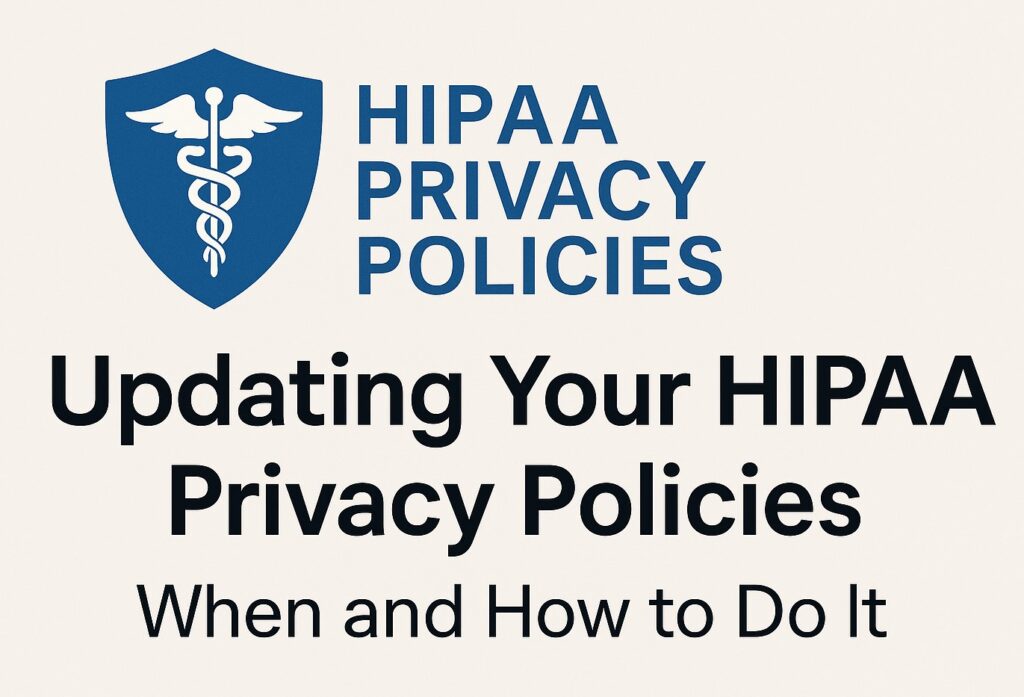Updating Your HIPAA Privacy Policies: When and How to Do It
In today’s fast-changing healthcare landscape, maintaining HIPAA compliance is more than just having a privacy policy—it’s about keeping it current, effective, and aligned with evolving regulations. Outdated privacy policies can put your organization at risk of violations, hefty fines, and data breaches.
This article explains when to update your HIPAA Privacy Policies and how to do it effectively to ensure your organization remains compliant and protected.
Why Updating HIPAA Privacy Policies Matters
HIPAA (Health Insurance Portability and Accountability Act) sets the standard for protecting sensitive patient information. However, compliance isn’t a one-time task—it’s an ongoing process.
Regular updates to your privacy policies ensure that:
-
Your practices reflect the latest regulatory changes.
-
Staff follow the most current procedures for handling PHI (Protected Health Information).
-
You reduce the risk of breaches and penalties due to outdated policies.
Keeping your policies up to date demonstrates a commitment to patient trust, transparency, and security.
When Should You Update Your HIPAA Privacy Policies?
Here are the most common scenarios when an update is necessary:
1. When Regulations Change
HIPAA regulations may be updated or clarified by the Department of Health and Human Services (HHS).
For example, new rules about data sharing, telehealth, or patient rights could require changes to your existing privacy policies.
2. When You Adopt New Technology
If your organization introduces new systems like electronic health records (EHRs), cloud storage, or telemedicine platforms, your policies must reflect how PHI is stored, accessed, and transmitted.
3. After a Breach or Security Incident
Any security incident or data breach should trigger a thorough review of your privacy and security practices. Updating policies after such events helps close gaps and prevent recurrence.
4. When Business Operations Change
Mergers, acquisitions, new business associates, or outsourcing services can all affect PHI handling. Update policies to reflect these new workflows and relationships.
5. On a Regular Schedule
Even without major changes, it’s best practice to review and update HIPAA privacy policies annually. A yearly review ensures that your organization remains compliant and that staff are working with the latest information.
How to Update Your HIPAA Privacy Policies
1. Conduct a Compliance Review
Start by performing a HIPAA compliance audit to identify outdated policies, gaps, and risks. Review your Notice of Privacy Practices (NPP) and all employee procedures related to PHI.
2. Consult Legal and Compliance Experts
Engage HIPAA compliance officers, attorneys, or consultants who specialize in healthcare privacy. Their expertise ensures that updates align with federal and state laws.
3. Update Policies and Procedures
Revise all relevant documentation, including:
-
Data access protocols
-
Breach notification procedures
-
Business associate agreements
-
Patient rights policies
Ensure these documents reflect current laws and technology standards.
4. Retrain Your Workforce
After updating, train all staff on the new policies. Employees must understand how changes affect their day-to-day responsibilities and PHI handling practices.
5. Document and Communicate Changes
Keep detailed records of when and why updates were made. Notify patients if your Notice of Privacy Practices changes significantly, as required by HIPAA.
Best Practices for Maintaining Updated HIPAA Policies
-
Schedule annual policy reviews with your compliance officer.
-
Monitor HHS updates for regulatory changes.
-
Test your procedures with mock audits or compliance drills.
-
Encourage reporting of potential policy gaps or violations.
-
Maintain version control—always keep an archive of past policies.
Final Thoughts
Updating your HIPAA privacy policies isn’t just about staying compliant—it’s about protecting your patients, staff, and reputation.
By reviewing policies regularly, adapting to change, and training your workforce, you ensure your organization remains compliant and trusted in the healthcare community.
